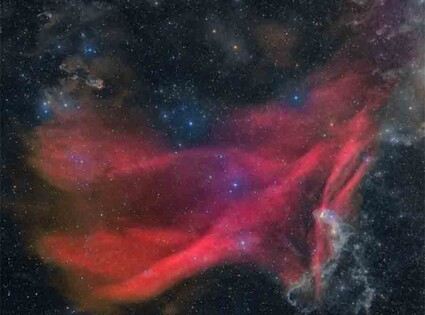Stars over Sisters 10/04/2022
Last updated 10/4/2022 at Noon
Autumn has begun and constellations of the season are becoming visible. The more familiar of them include Andromeda, Aquarius, Cassiopeia, Pegasus, and Perseus. This month, however, we are featuring a lesser-known stellar grouping — namely, Lacerta, the Lizard.
Although Lacerta is relatively faint and small (only 19 of the 88 constellations take up less space on the celestial sphere), it will not escape the detection of a diligent observer on a clear, moonless October night here in Sisters. It is bordered by Andromeda, Cassiopeia, Cepheus, Cygnus, and Pegasus. Lacerta lies north of the star Eta Pegasi and is recognizable to many as a small W in the sky, similar to the constellation of Cassiopeia. In fact, it is sometimes referred to as “Little Cassiopeia.”
The constellation’s brightest luminary, with a magnitude of 3.8, is Alpha Lacertae. This is an ordinary A-type main-sequence star that has more than twice the mass and size as our sun. It is a relatively young star, estimated to be approximately 400 million years old, and lies at a distance of some 103 light-years.
Lacerta has very few deep-sky objects, none of which are listed in Messier’s catalog. It does, however, contain one of the largest nebulas in the sky. The Great Lacerta Nebula is an emission nebula that spans a distance equal to six full moons, about the same angular size as the Andromeda Galaxy! But it is exceedingly faint. The photograph accompanying this article was produced by taking several exposures, each 10 hours long, over six nights, and combining them. The waves of clouds glow red because the hydrogen gas is ionized by a nearby star.
Unlike most of the other constellations, Lacerta doesn’t have its origins in Greek or Roman mythology. It was introduced in 1687 by Polish astronomer Johannes Hevelius.
The Orionids Meteor Shower will peak on the night of October 21 and early morning of October 22. The meteors will be most active after midnight, and a waning crescent moon won’t be bright enough to spoil the show. It is predicted that up to 20 meteors an hour can be seen, appearing to emanate from the constellation of Orion, but also appearing elsewhere throughout the sky. This shower is caused by ice and dust particles left behind by Halley’s Comet.
The solar system’s two largest gas giants rule the evening sky this month. Saturn is in eastern Capricornus, while the much brighter Jupiter currently resides in Pisces. Though technically not yet an evening object, Mars rises at about 10 p.m.
Mercury can be found hugging the eastern horizon at dawn for most of the month. Venus is out of view since it will be at superior conjunction on October 22, as it transitions from a morning to an evening object.
The month opens with a waxing moon that becomes full on October 9 (the Hunter’s Moon). Thereafter, the moon will be on the wane until October 25, when the new moon arrives. The best time for stargazing will be during the nights surrounding new moon, as its absences will darken the sky.
This month’s new moon on October 25 also brings with it a partial solar eclipse that will be visible from Europe, the Urals, Siberia, Asia, and northeastern Africa. More than 80 percent of the sun’s disk will be obscured in Central Russia. The event cannot be seen from anywhere in North America.
Our dark-sky tip for October is to use shielded outdoor lighting that angles light directly toward the ground. A lamp is properly shielded only when opaque barriers prevent the light source from being seen some distance away, such as from the street to your house.












Reader Comments(0)